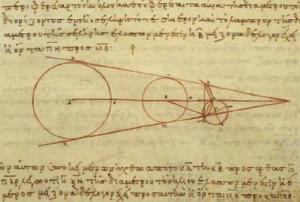Blog
Far and Away
22 January 2014

Yesterday I wrote a guest post on Starts With A Bang! about how we determine the age of the universe. Part of the post dealt with how we determine stellar distances. For close stars this can be done using parallax, but this relies on knowing the size of the Earth’s orbit. Just how we know the scale of our solar system is something I didn’t go into, but it does raise an interesting question. Just how did we first determine the scale of the solar system?
 John Landstreet
John LandstreetEarly determinations of astronomical distances were done relative to other distances. For example, in the mid-200s BCE, Aristarchus of Samos determined the distances to the Moon and the Sun in terms of Earth radii. The way he measured the distance to the Sun is by measuring the angle between the Sun and the Moon when the Moon was in the First Quarter or Last Quarter phase, meaning that half of the Moon is illuminated. Aristarchus argued that if half the Moon is illuminated, the Earth-Moon line and Moon-Sun line must be at right angles. Thus measuring the angle between Moon and Sun allowed him to use a bit of trigonometry to determine the distance to the Sun as a ratio of Moon distances. From his measurements, Aristarchus determined the Sun was about 20 lunar distances from Earth. The actual value is about 400.
To measure the distance from the Earth to the Moon, Aristarchus looked at the shadow of the Earth on the Moon during a lunar eclipse. Since the Sun and Moon have the same apparent size in the sky, if the Sun is x times more distant than the Moon it must also be x times larger. Thus Aristarchus could determine the angle of the Earth’s shadow relative to the Sun in terms of Earth radii (seen in the image above) By observing the Earth’s shadow on the Moon, he could then determine the distance to the Moon in Earth radii. Aristarchus got a value of 20, though the actual value is about 60.
The results of Aristarchus weren’t very accurate, but they were an early attempt to measure things that were far and away.